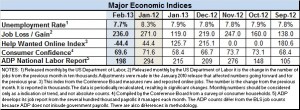 Economists were surprised and investors pleased by a jobs report this morning that said 236,000 jobs were created in February, which helped bring the U.S. unemployment down to 7.7%, the lowest in four years.
Economists were surprised and investors pleased by a jobs report this morning that said 236,000 jobs were created in February, which helped bring the U.S. unemployment down to 7.7%, the lowest in four years.
Every survey conducted before the numbers were released by the Labor Department had the average prediction showing between about 150,000 and 165,000 jobs added in February. Most also predicted that January’s 7.9% unemployment rate wouldn’t change. ADP’s job count, prepared by Moody’s Analytics and released Wednesday, came the closest to today’s numbers, reporting 198,000 private sector jobs were created during the month.
The jobs growth came across a broad range of sectors. The temp industry and employment agencies — registries, search, and the like — accounted for 21,100 new jobs in February, with the temp sector contributing 16,000.
Overall, the private sector created 246,000 nonfarm jobs, with the biggest gains coming in:
- Construction — up 48,000 principally coming in the specialty construction trades;
- Health care — up 32,000, with the gains coming in hospitals, doctors’ offices, and nursing and residential facilities;
- Leisure and hospitality — up 24,000, with nearly all the gains coming from job growth in food services, bars and restaurants;
- Retail — up 23,700 spread across a broad group of stores;
- Manufacturing – up 14,000.
The biggest growth — 73,000 new jobs — came in the Business and Professional Services category, a catchall that includes jobs in a broad range of industries and occupations including computers, janitorial, accounting, law, architecture, and the temp and employment services sector. Within this group, the biggest gains came from the temp industry and the hiring of accountants and bookkeepers, the likely result of tax season hires.
Government job losses cut the total increase by 10,000. The U.S. Bureau of Labor Statistics, which compiles the report, also revised its initial reports for January and December. January was reduced by 38,000 to a gain of 119,000 and December’s figure revised 23,000 jobs up to 219,000.
Forbes quoted Capital Economics chief U.S. economist Paul Ashworth telling investors that the report “isn’t a game changer,” though “it adds to the evidence from the upbeat ISM surveys released earlier this week that, despite the expiry of the payroll tax cut, higher gasoline prices, and government spending cuts, the recovery is gathering momentum.”
Another encouraging sign in the report prepared by the Bureau of Labor Statistics is the increase in the average workweek. It expanded by .1 hour to 34.5 for all employees on non-farm payrolls. The manufacturing workweek also lengthened by .2 hours to 40.9, and factory overtime increased to n average of 3.4 hours. Lengthening work hours, and especially overtime, is considered an early indicator — if it continues — of job growth.
SHRM’s LINE report, issued yesterday, predicts that hiring will continue strong. Says the report: “In March, hiring rates will approach four-year highs for the month in both manufacturing and services.”
The LINE report, based on surveys of SHRM member recruiters, also says that recruiting will continue to be difficult for services industries, and a bit easier for manufacturers:
A net of 8.5 percent of manufacturing respondents had more difficulty with recruiting in February. This is a decline of 9 points from February 2012. A net of 10.4 percent of service-sector HR professionals had more difficulty recruiting in February, an increase of 15.6 points from a year ago and the highest net level of recruiting difficulty in four years for the month of February.
The BLS report, meanwhile, suggests that the decline in the unemployment rate was helped both by the job growth and by a slight decline in the number of people declaring themselves to be in the workforce. The ranks of the unemployed did decline between January and February; at 12 million, the number of unemployed is about .5 million less than a year ago, on a seasonally adjusted basis. Of those, 4.8 million have been out of work for more than half a year, a number little changed in the last few months, but .6 million fewer than a year ago.
In addition, another 8 million are working part time because they can’t find full-time jobs.